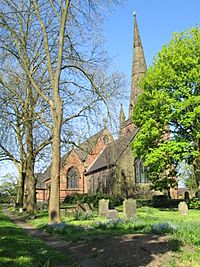St Margaret's Church, Wolstanton facts for kids
Quick facts for kids Church of St Margaret |
|
|---|---|
 |
|
| 53°1′46.9″N 2°12′56.0″W / 53.029694°N 2.215556°W | |
| OS grid reference | SJ 856 481 |
| Country | United Kingdom |
| Denomination | Church of England |
| History | |
| Dedication | Saint Margaret |
| Architecture | |
| Heritage designation | Grade II* |
| Designated | 21 October 1949 |
| Architect(s) | Ward and Son Anthony Salvin |
| Style | Decorated |
| Specifications | |
| Bells | 8 |
| Administration | |
| Diocese | Diocese of Lichfield |
St Margaret's Church is a historic Anglican church located in Wolstanton, Staffordshire, England. It is part of the Diocese of Lichfield. This beautiful building is very important, so it has a special protection status as a Grade II* listed site. This means it's recognized for its historical and architectural value.
What Makes St Margaret's Church Special?
The village of Wolstanton was mentioned way back in the Domesday Book of 1086. This old book even recorded that the village had a priest! Parts of the church building are very old, dating back to the medieval period. For example, the church's tower and its unique eight-sided spire stand on foundations from medieval times. What's interesting is that the spire is on the north side of the church, which is a bit unusual.
The church is built in a style called "decorated architecture." This style was popular in England during the medieval period. The church has been rebuilt and updated over the centuries. A major rebuilding happened in 1623. Then, in 1860, a big renovation took place, led by architects Ward and Son. The chancel, which is the part of the church near the altar, was designed by a famous architect named Anthony Salvin.
Inside the Church
When you step inside St Margaret's, you'll see the main part of the church, called the nave. It has arcades with four sections, which are rows of arches supported by columns. Look up, and you'll notice a special type of ceiling called a hammerbeam roof. This kind of roof uses wooden beams that stick out from the walls, making the space feel open and grand.
There's also a beautiful wooden screen in the chancel. This screen has detailed carvings and designs.
You can find some old monuments inside the chancel. These are dedicated to the Sneyd family, who were important people in the area. One of the most notable is a large stone tomb from the 1500s. It's made of alabaster and honors Sir William Sneyd and his wife Anne. You can see their statues lying on top of the tomb. There are also other plaques on the walls remembering different members of the family.
The Church Bells
St Margaret's Church has eight bells! Six of these bells are very old; they were made in 1714 for a different church in Trentham. Later, in 1767, these six bells were moved and installed here at St Margaret's.
The Churchyard
The area around the church, called the churchyard, is also a place of history. It's where many people are buried.
One famous person buried here is Henry Faulds (1843–1930). He was a missionary and is known for his important work in developing the use of fingerprinting for identification. His discoveries helped solve crimes and identify people.
The churchyard also holds the grave of Sarah Smith, who passed away in 1763 when she was only 21 years old. Her gravestone has a very old and interesting inscription. It suggests that she might have been harmed, and it even hints at who might have been responsible. This particular grave is also protected as a Grade II listed site because of its historical significance.

